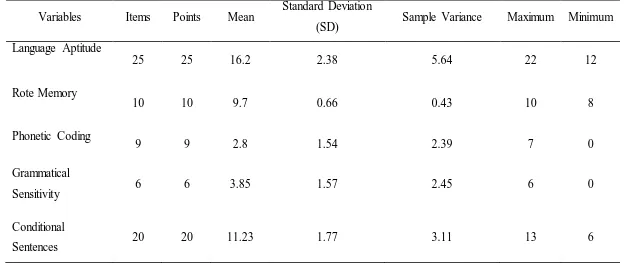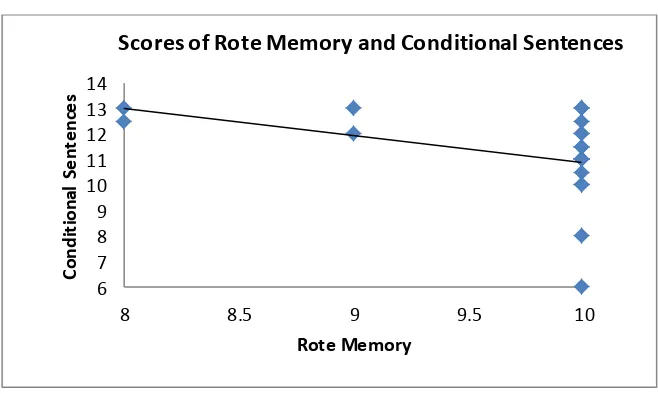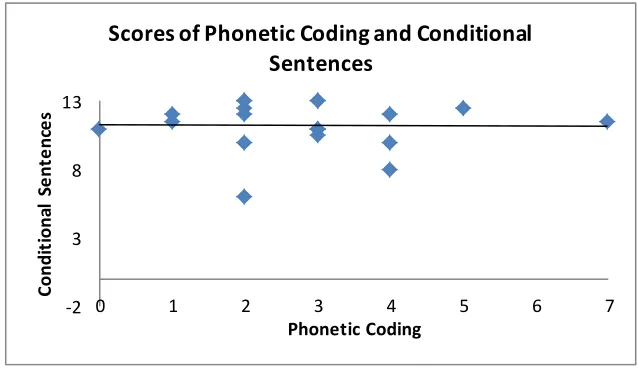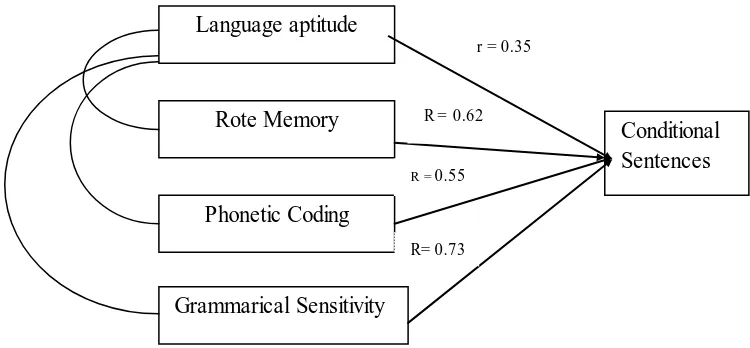Nurdini, 2014
LANGUAGE APTITUDE AND ITS RELATION TO ENGLISH SECOND LANGUAGE LEARNERS’ MASTERY OF GRAMMATICAL RULES
Universitas Pendidikan Indonesia | repository.upi.edu | perpustakaan.upi.edu
CHAPTER IV
FINDINGS AND DISCUSSION
This chapter contains findings gathered after analyzing the correlation of language
aptitude and English second language learners‟ mastery of conditional sentences. The analysis included analyzing the correlation of language aptitude and English
second language learners‟ mastery of conditional sentences by using Pearson product moment correlation coefficient. The next steps were analyzing the
coefficient of determination and level of significance for both variables.
Furthermore, the study also analyzed the correlation of language aptitude‟s three
constituent abilities such as Rote Memory, Phonetic Coding, and Grammatical
Sensitivity with the result of the test on conditional sentences for the learners.
4.1 The Correlation of Language Aptitude and English Second Language Learners’ Mastery of Conditional Sentences
4.1.1 Score Tabulation
This study used two main instruments; the first was the Modern Language
Aptitude Test (MLAT) to measure the English second language learners‟
aptitude, while the second one was test on conditional sentences which
was used to measure the second language learners‟ mastery of English
conditional sentences. The MLAT consisted of five parts and 25 questions
in total. As mentioned in Chapter III, Part I consisted of 4 questions, Part II consisted of 5 questions, Part III consisted of 4 questions for each part,
Part IV and Part V consisted of 6 questions for each. One point was given
for every right answer, while the wrong answer scored zero.
Twenty questions were available on test on conditional sentences.
The test consisted of 10 essays and 10 matching exercises regarding
Nurdini, 2014
LANGUAGE APTITUDE AND ITS RELATION TO ENGLISH SECOND LANGUAGE LEARNERS’ MASTERY OF GRAMMATICAL RULES
constituent abilities of language aptitude are presented in Appendix II.
Nurdini, 2014
LANGUAGE APTITUDE AND ITS RELATION TO ENGLISH SECOND LANGUAGE LEARNERS’ MASTERY OF GRAMMATICAL RULES
Universitas Pendidikan Indonesia | repository.upi.edu | perpustakaan.upi.edu 4.1.2 Preliminary Data Analysis: Descriptive Statistics
The descriptive analysis is given to provide information regarding two
variables in the study. The information includes standard deviation (SD),
sample variance, range, minimum and maximum score. Along with the
descriptive statistics, this chapter also provides information regarding the
measurements which are needed in this study. As mentioned in Chapter III, the study used language aptitude test, which is called the Modern Language Aptitude Test (MLAT), and test on conditional sentences for 20
students who were willing to volunteer for the study.
The MLAT consisted of 25 questions, while test on conditional
sentences consisted of 20 questions. The MLAT was used to measure the
subjects‟ language aptitude and their abilities in aptitude‟s constituent
abilities, such as Rote Memory, Phonetic Coding, and Grammatical
Sensitivity, while test on conditional sentences was used to measure their
mastery of the material. The following table summarizes the descriptive
Nurdini, 2014
LANGUAGE APTITUDE AND ITS RELATION TO ENGLISH SECOND LANGUAGE LEARNERS’ MASTERY OF GRAMMATICAL RULES Universitas Pendidikan Indonesia | repository.upi.edu | perpustakaan.upi.edu
Table 4.1
Descriptive Statistics (N = 20)
Variables Items Points Mean Standard Deviation
(SD) Sample Variance Maximum Minimum
Language Aptitude
25 25 16.2 2.38 5.64 22 12
Rote Memory
10 10 9.7 0.66 0.43 10 8
Phonetic Coding
9 9 2.8 1.54 2.39 7 0
Grammatical
Sensitivity 6 6 3.85 1.57 2.45 6 0
Conditional
35 As shown in the Table 4.1, the mean of language aptitude which
measured by the Modern Language Aptitude test is 16.2 (SD = 2.38),
which is 64.8% of the total score (25), while the mean for test on
conditional sentences is 11.23 (SD = 1.77), which was 56.15% of the total
score (20). The sample variance of the data ranged from 0.43 to 5.64.
In MLAT, there are five main parts in which the test takers are
expected to answer. Part I [Number Learning] and Part V [Paired
Associate] were used to measure the test takers‟ memory, in this case is
called Rote Memory. Part II [Phonetic Script] and Part III [Spelling Clues]
were used to measure the test takers‟ Phonetic Coding ability, while Part IV which is called Words in Sentences was used to measure the test takers‟
sensitivity of grammatical concept or in this case is called Grammatical
Sensitivity.
4.1.3 Language Aptitude and English Second Language Learners’ Mastery
of Conditional Sentences
In order to find out the correlation of language aptitude and English
second language learners‟ mastery of conditional sentences, this study
used the Modern Language Aptitude Test (MLAT) to measure the
learners‟ language learning ability, while test on conditional sentences was used to measure learners‟ mastery of conditional sentences. Using Pearson product moment correlation coefficient, the relationship between language
aptitude and English second language learners‟ mastery of conditional
sentences in the study is 0.35. The figure 4.1 elaborates the scatter diagram
or best-fit line of the correlation of language aptitude and English L2
36 Figure 4.1 The Sca tter Plot of MLAT a nd Test on Conditiona l Sentences (N = 20)
From the figure above, it is shown that there is a linear relationship
between language aptitude which is represented by horizontal axis
(variable X) and English L2 learners‟ mastery of conditional sentences
English second language learners‟ mastery of conditional sentences is
0.35, it means the relationship reflects a weak positive relationship.
4.1.3.1 Rote Memory
37 that the value of R of language aptitude and Rote Memory with
English second language learners‟ mastery of conditional sentences
is 0.62. The result emphasizes that the two independent variables
and the learners‟ mastery of conditional sentences defines a strong
relationship since the value of R is closer to 1 (Bluman, 2012). To see whether Rote Memory employs linear relationship
with English second language learners‟ mastery of conditional
sentences, the figure 4.2 below explains the scatter diagram or best
fit-line for a linier relationship. The diagram is based on the scores
of Rote Memory, which can be measured by using Part I [Number
Learning] and Part V [Paired Associates] in the Modern Language
Aptitude Test, and test on conditional sentences.
Figure 4.2The sca tter plot of Rote Memory a nd Test on Conditiona l Sentences
(N = 20)
From the figure above, it is shown that there is a linear
relationship between Rote Memory which is represented by
horizontal axis (variable X) and English L2 learners‟ mastery of
conditional sentences which is represented by vertical axis
(variable Y). The dots of the scatter plot elaborates the distribution
38 conditional sentences taken by the samples of this study. Through
the figure above, it appears that the relationship or the association
of both variables is linear negative.
4.1.3.2 Phonetic Coding
Another constituent ability in language aptitude which is
investigated in the study is Phonetic Coding. It can be measured by
Part II [Phonetic Script] and Part III [Spelling Clues] in the
Modern Language Aptitude Test [MLAT]. Similar to Rote
Memory, Phonetic Coding and language aptitude are two
independent variables (X1 and X2), while English second language
learners‟ mastery of conditional sentences is dependent variable
(Y).
In accordance to the formula of multiple correlations, the
value of R of language aptitude and Phonetic Coding with English
second language learners‟ mastery of conditional sentences is 0.55. Looking at the obtained R of the investigated variables, it appears that there is a strong association between investigated variables. A
strong association ranges from 0.51 to 1.00 (Punithavalli &
Sharmi, 2013). The value of R of language aptitude and Phonetic
Coding with English second language learners‟ mastery of
conditional sentences is also closer to 1.00, so it means the
association is stronger (Bluman, 2012).
Furthermore, Figure 4.3 explains the scatter diagram or best
fit-line for a linier relationship. The diagram is based on the scores
39 Figure 4.3The sca tter plot of Phonetic Coding a nd Test on Conditiona l
Sentences (N = 20)
Based on the figure above, it is shown that there is a linear
relationship between Phonetic Coding which is represented by
horizontal axis (variable X) and English L2 learners‟ mastery of
conditional sentences which is represented by vertical axis
(variable Y). The dots of the scatter plot defines the distribution of
of both variables was linear negative.
4.1.3.3 Grammatical Sensitivity
The last constituent ability of language aptitude which is also
investigated in the study is called Grammatical Sensitivity. The
ability can be measured by using Part IV [Words in Sentences] in
the Modern Language Aptitude Test (MLAT). Using the formula
of multiple correlations, the value of R of language aptitude and
Grammatical Sensitivity with English second language learners‟
mastery of conditional sentences is 0.73. Looking at the obtained R
of the investigated variables, it appears that there is a strong
40 ranges from 0.51 to 1.00 (Punithavalli & Sharmi, 2013). The value
of R of language aptitude and Grammatical Sensitivity with
English second language learners‟ mastery of conditional sentences
is also closer to 1.00, so it means the association is stronger
(Bluman, 2013).
To see whether Grammatical Sensitivity employs linear
relationship with English second language learners‟ mastery of
conditional sentences, the figure 4.4 below explains the scatter
diagram or best fit-line for a linier relationship. The diagram is
between Grammatical Sensitivity and English second language
learners‟ mastery of conditional sentences. It reveals that there is a
linier relationship between Grammatical sensitivity, which is
represented by horizontal axis (variable X), and English L2
learners‟ mastery of conditional sentences which is represented by vertical axis (variable Y). The dots of the scatter plot defines the
distribution of the two variables, in this case the scores of
41 the samples of this study. Through the figure above, it can be
concluded that the relationship or the association of both variables
is linear positive.
Compared to the two other constituent abilities (Rote
Memory and Phonetic Coding), Grammatical Sensitivity has the
strongest correlation to English second language learners‟ mastery
of conditional sentences. It is expected since the study also dealt
with the concept of conditional sentences which is one of the
important subjects in comprehending English grammar.
Grammatical Sensitivity itself in Carroll‟s language aptitude theory
is “the ability to recognize the grammatical functions of words (or
other linguistic entities) in sentences structures” (Carroll, 1981, p. 105).
4.1.4 Coefficient of Determination of Language Aptitude and English
Second Language Learners’ Mastery of Conditional Sentences
Coefficient of determination can be defined as “the percent of the variation in the values of the dependent variable (Y) that can be „explained‟ by
variations in the value of the independent variable (X)” (Taylor, 1990, p.
37). To put it simply, coefficient of determination determines the degree of
contribution of variable X to variable Y. Coefficient of determination (r2) can be obtained by squaring the obtained r (Taylor, 1990).
The obtained r of language aptitude and English second language
learners‟ mastery of conditional sentences in the study is 0.35 and the squared r (r2) or the degree of contribution is 0.12. In other words, language aptitude as variable X contributed 12% to English second
language learners‟ mastery of conditional sentences. It also can be concluded that language aptitude explains 12% of English second
42
4.1.5 Level of Significance
Level of significance in a correlation is used to indicate “that the observed
sample data provides ample evidence to reject the null hypothesis that the
population correlation coefficient parameter (rho) is zero thereby concluding that the population correlation coefficient is not equal to zero”
correlation of language aptitude and English second language learners‟
mastery of conditional sentences is statistically significant. After
calculating the result by using the formula of the standardized t statistic for
the relationship between the two variables is statistically significant.
While using the same hypothesis, Rote Memory, Phonetic Coding,
and Grammatical Sensitivity used an F test for R by employing the formula in Chapter III. Choosing the 0.05 level of significance for two
tailed test with 18 degree of freedom numerator (d.f.N) and 17 degree of
freedom dominator (d.f.D), the study investigates whether there is a
significant correlation among investigated variables.
The result shows that the F test for Rote Memory and language aptitude as independent variables and English second language learners‟
43 result of F test is larger than 0, the null hypothesis (H0) can be rejected and
the alternative hypothesis can be accepted. It can be concluded that there is
significant relationship among language aptitude, Rote Memory, and
English second language learners‟ mastery of conditional sentences. It also
applies to Phonetic Coding (F = 3.78) and Grammatical Sensitivity (F = 9.98).
4.2 Chapter Summary
Using Pearson product moment correlation coefficient, it was found that the
correlation of language aptitude and English second language learners‟ mastery of
conditional sentences is 0.35. The study also investigates three constituent
abilities of language aptitude, which include Rote Memory, Phonetic Coding, and
Grammatical Sensitivity, with the learners‟ mastery of conditional sentences. The
formula used is the multiple correlation formula.
The result of the study shows that the multiple correlation of language
aptitude and Grammatical Sensitivity, as two independent variables, and the
learners‟ mastery of conditional sentences is 0.73, which is stronger compared to Rote Memory (R = 0.62) and Phonetic Coding (R = 0.55). Furthermore, the related variables in the study also indicate a significant correlation to each other.
Table 4.2 below presents the result of multiple correlation of language
aptitude and its three constituent abilities and English second language learners‟
44 Table 4.2 The Multiple Correlation of Language Aptitude and its Three
Constituent Abilities with conditional sentences
The Multiple
Correlation with
Conditional
Sentences
Language Aptitude
Rote Memory Phonetic Coding Grammatical
Sensitivity
R 0.62 0.55 0.73
F* 5.31 3.78 9.98
* H0: ρ = 0; H1= ρ 0 (two ta iled), choosing .05 level of significance with d.f.N: 18 a nd
d.f.D: 17; F = 2.01
Overall, the relationship of investigated variables can be concluded by
Figure 4.5 below.
Figure 4.5 The rela tionship of investiga ted va ria bles
Language aptitude
Rote Memory
Phonetic Coding
Grammarical Sensitivity
Conditional Sentences
r = 0.35
R = 0.62
R = 0.55




